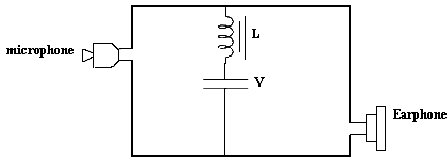Explain simple telephone communication system with circuit and equation of current flow in microphone?
Simple Telephone Communication: In the simplest type of a telephone circuit, there is one method communication including two entities, one receiving (listening) and another transmitting that is talking.

FIG - A Simplex Telephone Circuit
Simplex communication: The earphone and microphone are the transducer components of the telephone communication system. The earphone converts the electrical signals in audio signals and Microphone converts speech signal to electrical signals. Most usually used microphone is carbon microphone. Carbon microphones do not generate high fidelity signals, but provide out strong electrical signals at acceptable quality levels for telephone conversation. A certain quantity of small carbon granules is placed in a box, in carbon microphones. Carbon granules conduct electrically and the resistance offered through them is dependent on the density with that they are packed. One side the box is covered is flexible and is mechanically attached to a diaphragm. While sound waves impinge upon the diaphragm, this vibrates, causing the carbon granules to compress or expand, therefore changing the resistivity offered through the granules. If a voltage is applied to the microphone, the current in the circuit varies as per to the vibration of the diaphragm.
While the sound waves impinge on the diaphragm, the instantaneous resistance of the microphone is specified by
ri = r0 - r sinωt
Where
r0 = Quiescent resistance of the microphone while there is no speech signal.
r = Maximum variation in resistance offered through the carbon granules, r < r0.
The negative sign shows that when the carbon granules are compressed the resistance reduces and vice versa. Avoiding impedances external to the microphone in the circuit specified in figure without loss of generality, the instantaneous current in the microphone is specified by
i = V/(r0 - r sin ωt) = I0(1 - m sin ωt)-1
Here I0 = V/r0 = Quiescent current in the microphone. m = r/r0 , m < 1
Through binomial theorem, the equation may be expanded as i = I0 (1+ m sin ωt + m2 sin2 ωt + ....)
When the value of m is adequate small that is usually the case in practice, higher- order terms can be avoided in the above equation giving as:
i = I0 (1+ m sin ωt)
Therefore, the carbon granule microphone functions as a modulator of the direct current I that is analogous to the carrier wave in AM system. The quantity m is equal to the modulation index in AM.